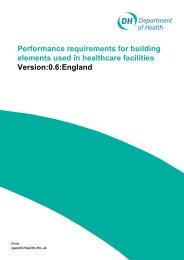Early Life Nutrition and Lifelong Health - Derbyshire Local Medical ...
Early Life Nutrition and Lifelong Health - Derbyshire Local Medical ...
Early Life Nutrition and Lifelong Health - Derbyshire Local Medical ...
You also want an ePaper? Increase the reach of your titles
YUMPU automatically turns print PDFs into web optimized ePapers that Google loves.
BMA Board of ScienceKarlberg described postnatal growth in three distinct phases – infancy, childhood <strong>and</strong> puberty. 164During infancy the fetal growth hormones, such as insulin <strong>and</strong> the insulin-like growth factors (IGFs)play a more important role than growth hormone. From six to 12 months, growth hormone startsto have a significant effect on growth <strong>and</strong> becomes the main endocrine growth regulator duringchildhood. <strong>Nutrition</strong>al status, especially during infancy, interacts with these hormones, <strong>and</strong> bothcirculating IGF-1 concentrations <strong>and</strong> receptors are reduced in undernutrition. Thyroid hormone isrequired for normal infant growth. In early infancy, gonadotrophin concentrations are high, <strong>and</strong>testosterone concentrations in boys are raised; they fall over the first six postnatal months to verylow levels that persist until the onset of puberty. There may be mild elevation of oestrogenconcentrations in girls in the neonatal period.The reasons for differences in weight gain <strong>and</strong> growth between breastfed <strong>and</strong> formula-fed babiesare not known. Formula milk contains more protein than breast milk, which may alter growthfactor concentrations. The greater control that the infant exerts over the flow of milk, <strong>and</strong> the‘supply <strong>and</strong> dem<strong>and</strong>’ interaction between infant <strong>and</strong> mother, may influence appetite, satiety <strong>and</strong>energy intake differently from formula-fed babies. ‘Inadequate growth’ is often a reason formothers deciding that they have insufficient milk, <strong>and</strong> changing to formula feeding (see pages 28<strong>and</strong> 29). There are also numerous social factors influencing parents’ infant feeding choices. Thiscomplex interplay between biological <strong>and</strong> societal influences makes it difficult to disentangle thefactors that control infant growth. 165Key message‘Inadequate growth’ is often a reason for mothers mistakenly deciding that they haveinsufficient milk, <strong>and</strong> changing to formula feeding.Recommendations about size <strong>and</strong> growth during infancyGrowth monitoring is one of the prime activities of health visitors <strong>and</strong> doctors looking after infantsin the UK. The aims are to detect inadequate weight gain or growth (‘failure to thrive’), which mayindicate illness or problems with feeding or diet, or excessive weight gain. Research suggests that itis important to parents that their child is ‘normal’ in size or growth 166 <strong>and</strong> a belief that an infant isnot gaining weight normally is one of the commonest reasons mothers give for stoppingbreastfeeding. The growth charts currently in general use in the UK are based on the 1990 UKreference data. 167-169 These came from a study of fetal growth in white Caucasian pregnancies inLondon, <strong>and</strong> Cambridge infants taking part in a study of the effects of infant feeding practiceson growth.In 2006, the WHO launched a new growth reference, which is now recommended for useworldwide. 170 There were a number of reasons for developing the new reference. Formula-fedinfants gain weight more rapidly after the first four to six months than breastfed infants 162 <strong>and</strong>studies had shown that the weight gain pattern of breastfed infants deviated considerably frommost current reference data. 171 An optimal reference was considered to be that based exclusivelyon breastfed infants. Infants from all ethnic groups can grow equally well, given an optimalenvironment <strong>and</strong> adequate nutrition, <strong>and</strong> a unified st<strong>and</strong>ard would have benefits for comparingdata from different populations. The WHO has defined the new reference as a st<strong>and</strong>ard ratherthan a reference, ie a description of how children should grow. The infants from which it wasderived lived in conditions ‘favourable to child growth’: they were singletons born at full-termwithout major neonatal morbidity; had no known health or environmental constraints to growth;38<strong>Early</strong> life nutrition <strong>and</strong> lifelong health



